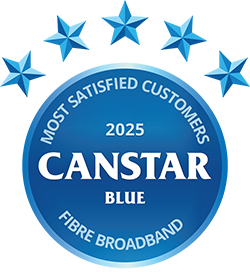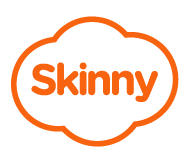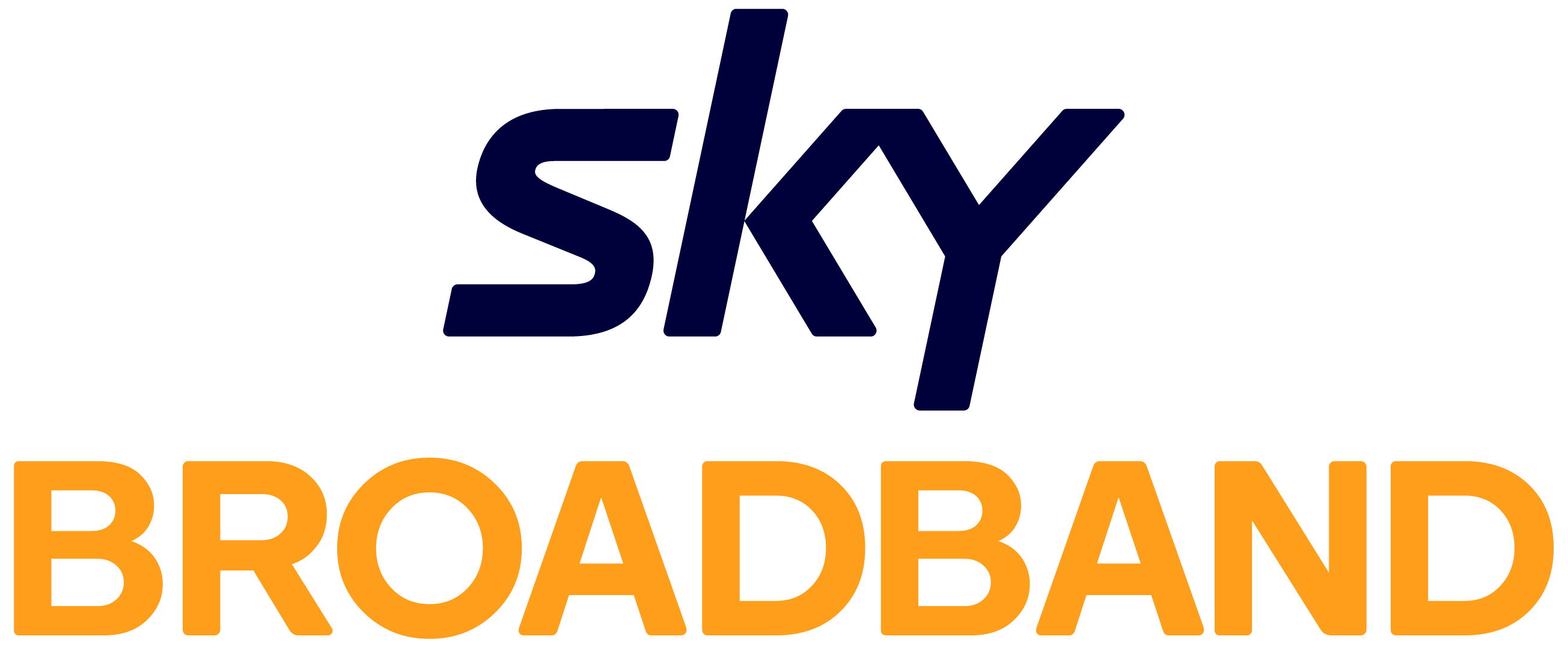Compare fibre broadband providers in New Zealand at Canstar Blue. Now, Nova Energy, Skinny, Slingshot, Sky, Spark, 2degrees and One NZ were compared on Overall Satisfaction, Bill Clarity, Clarity of Contract, Customer Service, Flexibility of Contract, Network Performance and Value for Money.
See our Ratings Methodology.

For the fifth time in six years, Now has been rated No.1 for customer satisfaction by Kiwi broadband consumers.

Our review compares providers that offer standalone fibre broadband on customer satisfaction, so you can discover what other Kiwis think about our compared fibre broadband providers before you sign on with one of them. Think of it like asking hundreds of your closest friends and family which fibre broadband provider they think is best!
Canstar Blue surveyed 2576 Kiwis who have an account with a fibre broadband provider and asked for their feedback on their broadband provider.
Respondents rate their satisfaction with their providers from zero to ten, where zero is extremely dissatisfied and ten is extremely satisfied. Brand satisfaction was rated by respondents on the following criteria:
The winning brand is the one that receives the highest Overall Satisfaction rating once all the scores from the Overall Satisfaction criteria are combined and averaged.
Brands must have received at least 30 responses to be included, so not all brands available in the market have been compared in this survey. The brands rated in this survey are listed below in order of best overall satisfaction.
Find more information on our Most Satisfied Customer methodology.


This year marks five award wins out of six for Now, which once again dominates our Fibre Broadband Award earning top praise from its customers. It’s the only broadband provider to earn a 5-Star rating for Overall Satisfaction, a result it replicates across another four award categories, including Customer Service.
Overall, Now collects more top ratings than the other seven broadband providers on our table combined.
Now has come a long way since its establishment nearly 20 years ago, as a rural provider in Hawke’s Bay. Since then, it’s grown into a nationwide company with offices in Napier and Christchurch. Now offers a range of broadband solutions for business and personal customers.
Extra costs apply for a modem.
Plans come with access to the great Now Assist app that provides clear prompts to help fix common internet problems. It also links through to Now’s support team, should you need one-on-one assistance with your home broadband.

Sitting in second place, Nova Energy is one of only two brands on our table to earn multiple 5-Star ratings, for Network Performance and Bill Clarity. Across all other award categories, Nova earns great 4-Star ratings.
Nova Energy offers broadband, electricity, gas and mobile services. It has three broadband plans and generous discounts for bundling utilities.

Given its great value phone deals, it’s perhaps no surprise that Skinny earns a top 5-Star rating for Value for Money from Kiwi consumers for its fibre broadband deals. While it earns a 3-Star rating for Customer Service, it achieves great 4-Star ratings across all other categories, including for Overall Satisfaction.
In addition to its no-frills prepaid mobile plans, Skinny offers a great range of broadband deals across fixed and wireless. Free modem on 12-month contract, plus save $10 per month on broadband plans while you have an active eligible Skinny mobile plan.

Slingshot earns predominantly great 4-Star ratings, including for Overall Satisfaction, Value for Money and Customer Service.
Slingshot is part of the 2degrees group. It offers a range of wireless and fibre plans, plus savings for bundling broadband and power.
Contract terms 12- or 24-month. BYO modem, or $5/month ($15 delivery fee) on fibre plans.

Sky Broadband earns predominantly 4-Star ratings from its customers, including for Value for Money. Its two 3-Star ratings are for Customer Service and Bill Clarity.
Sky Broadband is available for both Sky TV subscribers and non-subscribers. There are three unlimited fibre plans to choose from, available on 12-month contracts.
However, keep in mind the additional Sky TV subscription costs when weighing up the bundle price. Sky Starter (the base Sky TV package) is $25.99 per month.
On top of these prices, if you’re a Sky TV subscriber there is the possibility of other costs, such as additional channel packages, and added Sky Box box functionality.

Spark is one of the country’s biggest telcos, and earns its best ratings, 4-Stars, for Overall Satisfaction, Bill Clarity and Network Performance. Across all other categories, Spark receives 3-Star ratings. However, while not a top rating, 3 Stars is by no means a measure of dissatisfaction, rather it shows Spark’s customers are content with the levels of value and service they receive.
Spark offers a range of fixed and wireless unlimited broadband plans. Although it’s worth noting that a modem is an extra $150, or you can BYO on fibre plans:
*Benefits include Netflix Standard ($25.99/month) and McAfee Security Standard ($4.95/month).
Extras: add Neon to your plan for $19.99 per month.

2degrees’ no-frills broadband plans deliver the telco company 4-Star ratings in the important categories of Value for Money and Network Performance. Across all other categories 2degrees earns 3-Star ratings.
2degrees has no-frills fibre and wireless broadband plans to meet all budgets and internet usage needs.
Connection fee of $99 on open term. Router rental $5/month + $15 shipping fee, or BYO.
Includes free modem on 12-month contract ($15 shipping fee).
$10/month discount across all plans if you have an eligible 2degrees pay monthly phone plan. Power discounts also available.

One NZ rounds out our awards table with 3-Star ratings across all categories except for a 4-Star rating for Network Performance.
One NZ offers a range of fibre, VDSL and wireless broadband plans:
SuperWifi modem rental $5/month on 12-month contract plus $14.95 delivery fee, or BYO with no fixed term.
Note: All prices correct as of 24/06/2025 and don’t include special offers. For further details, visit individual providers’ websites.
 Other broadband providers
Other broadband providersNot all broadband providers in the market qualify for our ratings (based on minimum survey sample size), but that doesn’t mean they’re not worth considering. Here are more broadband providers to check out before making a decision.
 Bigpipe
BigpipeBigpipe broadband is a no-frills broadband provider that is owned by Spark NZ. It was one of the first broadband providers to offer UFB with no data caps. It offers two fibre plans:
BYO modems only. $49 connection fee on open term plans.

Zeronet is a smaller, independent Kiwi telco company. It offers fibre and hyperfibre plans:
One-off connection fee of $35 applies. Router fees apply: $60 repayable bond and $15 delivery fee.

Canstar also rates and reviews Wireless Broadband providers, including Skinny, Spark, 2degrees and One NZ. For our latest Wireless Broadband Awards click here.

Many power companies now offer deals that bundle broadband with electricity, these firms include Electric Kiwi, Genesis, Slingshot, 2degrees, Nova Energy, Mercury and Contact. For our latest Bundled Utilities Award click here.
Value for Money is always a top consideration for all consumers in Canstar Blue’s awards, so it’s no surprise to see it rated as a No.1 concern for fibre broadband customers – on a par with Network Performance.
And it’s interesting to see that Customer Service is less important. Just 18% say it’s the most important factor when considering their satisfaction with their broadband providers.
Overall, here’s what the consumers in our survey say are their most important considerations when rating their broadband providers:

First, it pays to run an internet speed test. Start by connecting a device straight into your router with a LAN cable. This will reveal if it’s a problem with your internet supply.
Then run the test on multiple devices in different parts of your home. If the problem isn’t restricted to just one area of your home, or a particular device, it could be that your household’s data demands are too demanding for your internet plan (particularly if you’re not on fibre).
For example, 4G fixed wireless only hits around 40Mbps, which can struggle with even a single UHD Netflix stream. Although if you’re on fibre 300 and above, it’s unlikely you’re too demanding for your internet connection, unless you’re really pushing your bandwidth. For even fibre 300 can stream four UHD Netflix shows simultaneously without issue.
If the speed tests reveal your internet is, indeed, the problem, and your speeds are below where they should be, there are a few common reasons for this. Note that the problem could be a combination of a few issues:
Wi-fi routers aren’t the prettiest of devices. As a result, many of us tuck them away out of sight, or set them up in little-used rooms. But this is going to hinder your internet connection. When it comes to a strong wi-fi signal, walls and distances aren’t your friends.
Place your router high up, in an unobstructed location, and near your demanding devices, such as computers, smart TVs and gaming consoles.
Depending on the size of your property (or the density of your walls), it may be that one router isn’t up to the job. If your wi-fi is flying next to the router, but stuttering down the hall and in your bedroom, it may just be the signal is struggling to reach that far.
Wi-fi extenders can help. These don’t extend your wi-fi per se, rather they use your existing wi-fi connection to broadcast their own one. As a result, you’ll have more than one wi-fi network in your home. Your regular network, and the one broadcast by the extender(s).
Mesh routers, on the other hand, deliver a single cohesive wi-fi network that utilises a main router and then several nodes to boost the network around the home.
Mesh routers provide a better internet experience, but are more expensive than wi-fi extenders. However, some providers offer mesh routers as part of their broadband plans.
Router technology is constantly improving. An old router might still connect you to wi-fi, but it may do so at a slower rate. It can also leave your connection open to security risks, and might lack features that could improve your connection.
Modern routers feature a host of features that can improve your home’s wi-fi experience, such as:
If your router is getting old, it could be time to upgrade.
If your router has two networks for you to choose from – 2.4GHz and 5GHz – (as most routers do) this means you have a dual-band router.
Your router uses radio frequencies to transmit internet to your devices, and 2.4GHz and 5GHz refer to the frequency of those radio signals. To get the best out of your wi-fi connection, you need to utilise both in the correct way:
For this reason, it pays to set up your router close to your most demanding devices (gaming consoles, smart TV, work computers, etc.) so they can utilise the 5GHz network.
You can then connect most other things on 2GHz, which is perfect for devices far from the router, as well as things that don’t require much bandwidth. For example, most smart appliances can happily stay on 2GHz, even if they are close to the router.
Furthermore, try plugging demanding devices directly into the router via LAN cables. Not only does this improve the connection to those devices, but it frees up bandwidth for wireless devices. However, this may be impractical if your ONT and router are away from your bandwidth-hungry devices.
 Bruce Pitchers is Canstar NZ’s Content Manager. An experienced finance reporter, he has three decades’ experience as a journalist and has worked for major media companies in Australia, the UK and NZ, including ACP, Are Media, Bauer Media Group, Fairfax, Pacific Magazines, News Corp and TVNZ. As a freelancer, he has worked for The Australian Financial Review, the NZ Financial Markets Authority and major banks and investment companies on both sides of the Tasman.
Bruce Pitchers is Canstar NZ’s Content Manager. An experienced finance reporter, he has three decades’ experience as a journalist and has worked for major media companies in Australia, the UK and NZ, including ACP, Are Media, Bauer Media Group, Fairfax, Pacific Magazines, News Corp and TVNZ. As a freelancer, he has worked for The Australian Financial Review, the NZ Financial Markets Authority and major banks and investment companies on both sides of the Tasman.
In his role at Canstar, he has been a regular commentator in the NZ media, including on the Driven, Stuff and One Roof websites, the NZ Herald, Radio NZ, and Newstalk ZB.
Away from Canstar, Bruce creates puzzles for magazines and newspapers, including Woman’s Day and New Idea. He is also the co-author of the murder-mystery book 5 Minute Murder.
Currently subscribe to a paid video streaming service: 63%
Broadband provides value for money: 52%
Been target of online scam: 31%
Worry about time their children spend online: 21%
Watch >50% TV online: 36%
Watch all TV online: 27%
Watch <50% TV online: 26%
Watch no TV online: 8%
Canstar Blue surveyed 5127 New Zealand consumers across a range of categories to measure and track customer satisfaction, via ISO 26362 accredited research panels managed by PureProfile. The outcomes reported are the results from respondents who have a broadband internet account. In this case, 2576 New Zealanders. Brands must have received at least 30 responses to be included. Results are comparative and it should be noted that brands receiving three stars have still achieved a satisfaction measure of at least six out of 10. Not all brands available in the market have been compared in this survey. The ratings table is first sorted by star ratings and then by mean overall satisfaction. A rated brand may receive a ‘N/A’ (Not Applicable) rating if it does not receive the minimum number of responses for that criterion.
The past winners from Canstar Blue’s Broadband ratings:

Best-rated Fibre Broadband Providers - July 4th
KEY POINTS
Nova and Skinny cap speeds on all their plans once you hit your allotted data limits.
2degrees, One and Spark cap speeds, but also offer more expensive truly unlimited max-speed plans.
Mighty Mobile …

Best-rated Fibre Broadband Providers - July 4th
KEY POINTS
Group plans allow you to add between one and five people on your plan.
2degrees, Spark and One NZ offer discounts of approx 50% for added plans.
Electric Kiwi, Nova Energy and Rocket …

Best-rated Fibre Broadband Providers - July 3rd
KEY POINTS
The cheapest phone plans include 2degrees’ $8/m plan (150MB – 100mins & unlimited texts in NZ/OZ) | Skinny’s $8/m plan (250MB – 100mins & unlimited texts in NZ/OZ).
Most $30-$40/m plans offer unlimited …

Best-rated Fibre Broadband Providers - July 2nd
KEY POINTS
Many broadband providers offer special offers and deals to attract customers – this month’s best deals are listed below.
Discounts on broadband plans often only apply for a limited time, so it’s important …

Best-rated Fibre Broadband Providers - July 1st
KEY POINTS
Many mobile providers offer special offers and deals to attract customers – this month’s best deals are listed below.
Discounts often only apply for a limited time, so it’s important to be aware …